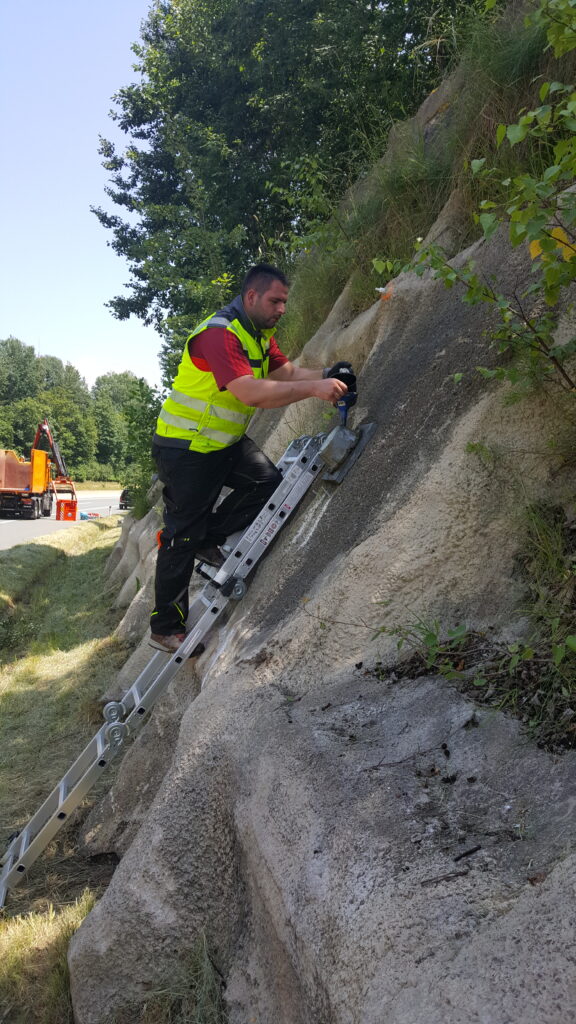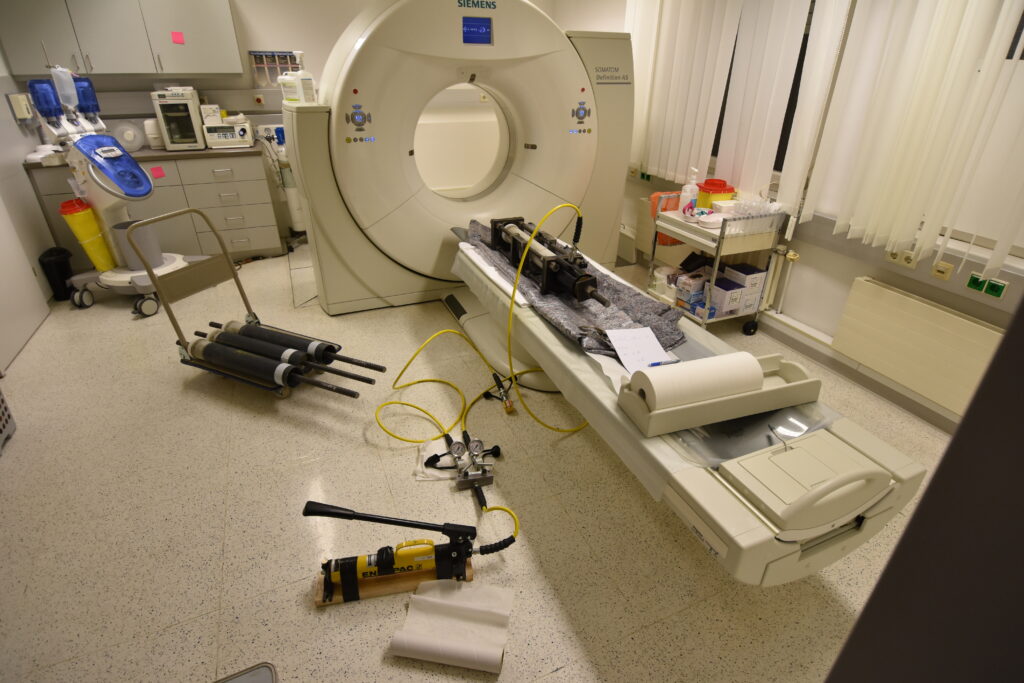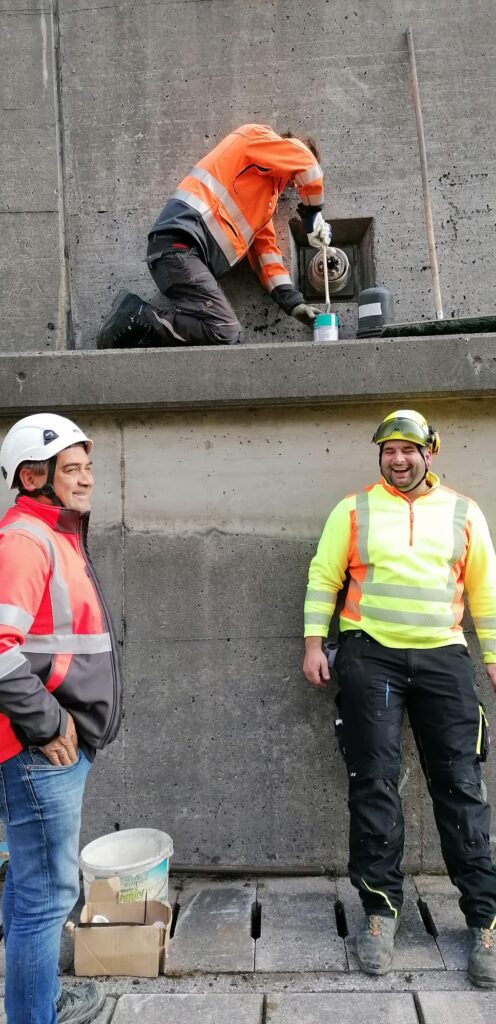Micropiles and giant excavators, Matthias J. Rebhan’s work includes everything from small devices to large machines. University research is conducted in dusty libraries, the scientists in their ivory towers are paler than Count Dracula from all the indoor work? Not at the Institute for Soil Mechanics, Foundation Engineering and Computational Geotechnics (IBG for short) at Graz University of Technology. The civil engineer and laboratory manager Rebhan talked to us about exciting projects, cool machines and the future of civil engineering.
*****
The employees at the IBG deal with “a wide range of geotechnical and structural issues related to geotechnics, foundation engineering and numerical geotechnics,” says Rebhan. Founded in 1964 by Christian Veder, the father of diaphragm wall technology, the institute was expanded in 1997 to include numerical geotechnics and now has 25 employees. “We work and do research on just about anything – which, among other things, is due to the possibilities of the university, but is certainly largely due to the interest of our institute director, Roman Marte.”
There is, for example, a dynamic test cylinder for micropiles under tension…

… or a new concept for recording the prestressing force in strand anchors:


Diverse portfolio
Giant trucks and micropiles can also be seen on Rebhan’s LinkedIn profile.
“Projects are currently running on anchor technology and the reliability of geotechnical structures, the monitoring of structures, the determination of subsoil parameters and the derivation and mapping of subsoil models, but also projects that go into the area of numerical simulation of construction and investigation methods.” In cooperation with the Institute for Manufacturing Technology they are currently developing a test device for micropiles for the introduction of tensile loads into the subsoil – this can be used in rockfall protection nets, for bank protection or the foundation of noise protection walls. “This project is currently a very instructive (albeit sometimes strenuous) activity, because on the one hand the ideas of civil engineers and mechanical engineers differ widely and on the other hand because we have found really new and innovative solutions here that will certainly accompany and challenge us for some time to come.”
There are also micropile and anchor tests, laboratory tests to determine subsoil parameters and expert opinions in the event of damage or problems.
Beyond institute boundaries
One project investigates the possibility of impulse testing of micropiles. Everyone involved in the project agreed that there must be a way to simulate such a load – but how? “We had the idea of applying the impulse via prestressed springs – but the energy density here is far too low.” The current solution consists of a prestressed hydraulic cylinder.
The solution (in the form of a prestressed hydraulic cylinder ) ultimately came from the Institute for Manufacturing Engineering – for Rebhan clear proof that the implementation of such projects at a university is of great added value because one can draw on expert knowledge from a wide variety of departments.
Because “every test – whether in the laboratory or in the field – usually requires an adapted test device or special equipment. The exciting point here is finding the right device for the task.” In the institute’s ‘vehicle fleet’ you quickly reach your limits, which is why you have to look for solutions elsewhere – and that is exactly one of the points that makes his work so attractive, says Rebhan. Creativity and a look beyond ones own institute’s boundaries is often required – what you are looking for can often be found in other disciplines, departments or institutions “like in one of the last projects with the fire brigade. This is also the reason why the work in the laboratory and experimental technology is so exciting and why the work at the university is so fulfilling that I wouldn’t trade it for anything else.”
This year, in order to complete two anchor technology projects a few last series of tests with new testing facilities still need to be done. In addition, field tests are pending “where we want to examine a special probe for measuring the soil pressure, for example, want to look at the properties of a thermally improved concrete for diaphragm walls, or where we want to test the load limits for ductile piles or micropiles made of wood.”

Expect the unexpected
Things rarely work out as expected. “Fortunately, nothing has gone monumentally wrong so far. Of course, some trials didn’t go as expected, but so far we’ve always managed to get the results we wanted – even if they weren’t what we expected. 😉”
For example it can sometimes happen that a micropile has to be subjected to computer tomography – much to the delight of the radiology assistants, Rebhan recalls: “It was their first patient who didn’t move during the imaging and wasn’t in pain.”
Another time, employees of the ASFiNAG route service expressed concern. They believed that the builders could destroy structures with their laser devices – a legitimate concern.
Outdated university research, conducted in dusty libraries? “A former professor at Graz University of Technology once said that “a good theory is very practical” – and I think that is exactly what describes the work at our institute very well.” Of course, even the most practical projects need a theoretical basis, but “fortunately we are not gathering dust during our work – because it has been shown that in large and small experiments, the child in all employees at the institute very quickly comes to light.”
Sustainable and innovative? Not exactly
Sustainability is a key issue that is particularly important to Rebhan. According to Rebhan, there is still a lot of room for improvement in the construction industry in this area. “A major focus in research must be sustainability, the conservation and saving of resources. We have a lot of catching up to do in the field of geotechnics – both in terms of construction methods and the use of building materials.”
However, interest in innovations and further development is there. The fact that the industry is still miles behind when it comes to digitization, for example, is not only due to the industry itself, “but also due to the fact that every project in the construction industry – whether it’s a single-family house or the construction of a new subway line – represents a special solution and therefore can only be compared with other projects to a limited extent.” Each problem is currently considered on its own, each problem solved individually – innovation is therefore only effective in individual cases and does not go beyond the construction site. Therefore there are hardly any learning effects.
Nonetheless: The potential for major innovations to advance the entire industry does exist, says Rebhan. “Innovation can be done in every area – materials, construction methods and digitization. However, I believe that sustainability and resource conservation (and not profit) must play a part in all innovations.”
*****

About Matthias Rebhan
Rebhan’s career in the construction industry started in the sandbox. “According to my mother, it was nearly impossible to get me out of the sandpit or take the Lego bricks away from me.” After graduating from high school, Rebhan actually wanted to stay in structural engineering. It was an exciting lecture of Roman Marte, board of directors of the IBG, that sparked his interest in geotechnics. What fascinates him is the wide range of tasks and the overlap with other areas of construction. Rebhan has been a technical employee at TU Graz since 2016 and a senior scientist and laboratory manager since 2021.
Credit: Rebhan/TU Graz
